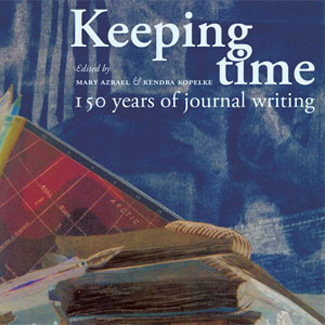Features
New Passager Book Opens the Pages of 150 Years of Journal Writing

The new book by UB's Passager Press is a collection of journal entries from dozens of contributors.
I think it a funny
way to live out doors
who would have though it
washing cooking outdoors
eating in a tent sleeping
in a wagon yet happy
Oh well such is woman
Beloved and Loving her life
So begins an early entry, a small slip of accidental poetry, from Keeping Time: 150 Years of Journal Writing, the latest collection from UB's own Passager Books. As its title conveys, it's a book made up of private journal entries from dozens of contributors, many of whom found diaries from family ancestors, or rescued them from junk shops or worse. The entries, many co-mingled with personal photographs, works of art and reproductions of actual journal pages, reach as far back as 1867—the year in which the above excerpt from "The Diary of William Easterly and Margaret P. Wilson Van Slyke" originates—and continue all the way to 2008. In this span of a century and a half is a rare, unvarnished portrait of what it means to write something for yourself, about yourself and your circumstances, good and bad.
Keeping Time, edited by Mary Azrael and UB's own Kendra Kopelke and now available on Passager's Web site, pays close attention to the details of the lives of immigrants, travelers and those who otherwise are in transition. Many entries, such as "Diary of a Teenager" by Liz Rhodebeck, a journalist and poet from Wisconsin, provide deep insights into the authors' perspective as they struggle with issues that at the time seemed all-consuming.
"I have often wondered if old people must get tired of each other after so many years or if love dies out for it is sometimes hard to see unionship between parents nowadays," Rhodebeck wrote on Feb. 25, 1970, when she was a 10th grader. She had been thinking about Theodore Dreiser's "The Lost Phoebe" and pondering her existence as only a teenager can. Assigned to keep a journal for English class, Rhodebeck poured out her emotions. Now, in retrospect, it's clear that she was doing more than that: she was exploring the writing life, learning to parse her thoughts as well as her sentences.
Keeping the journal "changed my life and set me on a path to being a writer," Rhodebeck said in her introduction.
Several contributors mined family lore for examples of honest self-expression and insight, while others simply found the diaries of strangers in antique shops and the like. Mary Pratt, a multi-talented person who has been both a teacher and an apple picker, submitted an entry entitled "Ella Fisher's Diary," from Vermont in 1900. In her introduction, Pratt said that she bought Fisher's diary for $12, and had only the first names of Fisher's husband and children in her search to find out who the author was. She used the Vermont census to discover Fisher's name. From there, she searched other records and discovered that Ella Fisher was a published poet who lived into her 80s.
"Visiting her gravesite and seeing those familiar names on tombstones was quite a moving experience, as was returning the diary to the family," Pratt said.
Fisher's entries are minimalist, but they have a lyrical cadence that reveals a poet:
Children go to the farm for milk.
Henry goes to the lake.
The old cow has a calf
& we shall have milk soon.
Other contributors, like photographer Stephanie Graham or Ann Zahn (both of Maryland), used the journal-keeping approach to tell stories about baby pigeons and the making of a quilt, respectively. Taken together, the written words, the photos, drawings and paintings of Keeping Time are an intimate, profound, occasionally tragic and arguably very American landscape.
'A Way of Paying Attention to Your Life': A Q&A with Kendra Kopelke

Kendra Kopelke
The Latest asked Kendra Kopelke, associate professor and program director for the M.F.A. in Creative Writing & Publishing Arts
in the School of Communications Design, to talk about her work as an editor of Keeping Time, the new book from Passager Press. Here's what she had to say:
The Latest: Although the book stretches over a century and a half of history as well as many lives and cultures, there are a handful of perspectives that persist throughout. If you had to describe the "themes" of the book, what would they be?
Kopelke: History and everyday life, time passing, beauty, loss, family, friendship ... introspection.
TL: What single entry is your favorite? Why?
Kopelke: Wow. That's a hard question. I have been surprised by the ones that have stuck with me—like Michael Estabrook's conversation with his father, who died when he was only 15, and the 1970 entries from a 15-year-old in English class, which take me back, instantly, to that time in my life. Not being an artist myself, I'm fascinated by the visual journals, their means of expression. They all bring me some kind of inspiration, news, or connection with another human being.
TL: You and your fellow editor Mary Azrael and the book's designer, Pantea Amin Tofangchi, push the form of journal presentation by integrating text and photos, or text and reproductions of the actual entries. The effect is one of intimacy. What inspired you to construct the entries in this way?
Kopelke: We wanted to recreate the experience of reading someone's actual journal, which is, as you say, very intimate, and at the same time present it in a way that unified the entries and allowed them to speak from a central place.
TL: How did you seek out the contributors? What are they saying about the book?
Kopelke: We put out a call to our Passager readers and asked for seven to 10 pages from their journals, either Xeroxes or typed copies. We had no idea what we would get, which was part of the excitement and part of the worry. We were thrilled to open the mail to find such old entries, dating back to the 1860s, and to hear the stories about where they came from. And then so touched by the visual journal of small watercolor paintings from a man who had just lost his wife.
Here are some contributors' responses:
Dear Kendra and Mary,
I just received my copy of Keeping Time. There's an expression in Spanish for exceeding everyone's expectations and doing an extraordinary job: "Hechar la casa por la ventana." (To throw the house out the window.) Well, you people did just that. The book is simply beautiful, very well put together and the content is well chosen and engrossing. Thanks so much for including me. I am honored. You should both be very proud.
Congratulations!
Diana Anhalt
Just received Keeping Time and I cannot tell you how impressed I am. It is a beautiful book, filled with great writing. The color pages are superb, everything so interesting and attractive and engaging. I got home Friday from a very long and tiring week of work and it had come in the mail that day. I had a quick look but was so tired could not muster the energy to read through it then and I'll be darned if it didn't keep me up even longer! I really couldn't put it down, so thanks a lot for the sleepless night!!!! (but it was worth it)
Sincerely,
Michael Estabrook
Dear Kendra, dear Mary,
What a lovely book! I'm so happy to have it. It is so handsome, so beautifully laid out and printed. I love the way you used the page from my dad's diary as a background. You folks deserve a lot of congratulations. Thanks for letting me be part of this.
Kudos!
Gloria
The books arrived and people are looking at the yoyo pages and the actual quilt and like Keeping Time very much. The more I read it the more people I know who would be interested in it—as journal keeping seems to be a popular pastime—especially with older people....
Hope for many sales!
Love, Ann Z.
Mary, Kendra,
I just finished reading the whole book and really loved it. What I loved the most was how real it is. It's like glimsping that true five minutes in everyone's consciousness, the truth. Surprisingly, what moved me the most was the poem/journal about a man in his 40s speaking to and seeking advice from his dead father. I can't wait til my son reads it. His father just died. Historically, politically, emotionally, I think this is a considerable contribution. I feel so proud to have my mother in it.
Thank you for your hard work, vision and wisdom,
Wendy
TL: Talk about the "Pigeons in the Planter" entry by Stephanie Graham—it's a collection of her wonderful photos and a bit of text. In the end she writes, "How could I have never noticed that incredible occurrence before in my life?" Sounds like something someone who keeps a journal would say, looking back over the years.
Kopelke: That's what journal keeping is about, and what it reminds us of, that journals are a way of paying attention to your life, in a way you wouldn't do otherwise. The result is often that you preserve meaning, and life's essences. When you read journals written by other people, you have that opportunity to enlarge your own life, your own reservoir of feeling. This book continues to feed me, the many times I have read it, I am drawn inside, to something that is inside me, waiting to be awakened.
